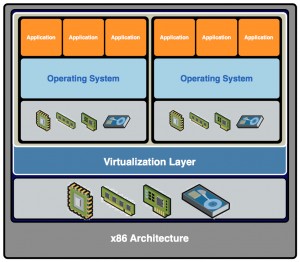Virtualization vs. Cloud Computing

Cloud Computing is a term used for hosted computing services delivered to the client over the internet, that services can be private, public or hybrid and are implemented with hardware and software to be presented as a utility to the users via a web browser.
It have several attractive benefits for businesses and end users. Three of the main benefits of cloud computing include:
- Self-service provisioning: End users can spin up computing resources for almost any type of workload on-demand.
- Elasticity: Companies can grow up as computing needs increase or grow down again as demands decrease.
- Pay per use: Users only have to pay for the resources and workloads that they use.
In the other hand we have virtualization. Virtualization is emulating a physical thing using software, that makes possible the creation of the virtual machines, that are a software implementation of a physical computer which runs an operating system and executes applications just like a real machine. With the help of the virtual machines you can run multiple applications and operating systems independently on a single computer.

The virtual machine has its own software-based CPU, memory, storage and network interface. In other words, the virtual machine emulates a complete computer inside your computer.
The main difference between these two technologies is that virtualization is a software that manipulates the hardware of the physical computer, while cloud computing is a service that is formed by virtualization. We can say that virtualization can exist without the cloud, but cloud computing cannot exist without virtualization. Also, in cloud computing is very important to deliver availability to any user at any time, which is not that inportant in virtualization.